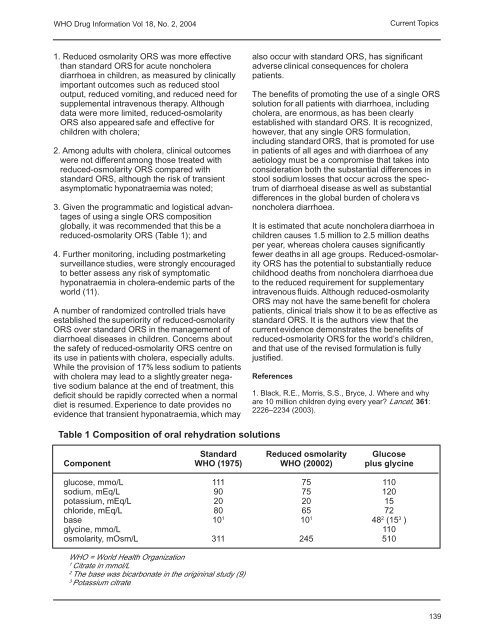WHO Drug Information Vol. 18, No. 2, 2004 - World Health ...
WHO Drug Information Vol. 18, No. 2, 2004 - World Health ...
WHO Drug Information Vol. 18, No. 2, 2004 - World Health ...
You also want an ePaper? Increase the reach of your titles
YUMPU automatically turns print PDFs into web optimized ePapers that Google loves.
<strong>WHO</strong> <strong>Drug</strong> <strong>Information</strong> <strong>Vol</strong> <strong>18</strong>, <strong>No</strong>. 2, <strong>2004</strong><br />
1. Reduced osmolarity ORS was more effective<br />
than standard ORS for acute noncholera<br />
diarrhoea in children, as measured by clinically<br />
important outcomes such as reduced stool<br />
output, reduced vomiting, and reduced need for<br />
supplemental intravenous therapy. Although<br />
data were more limited, reduced-osmolarity<br />
ORS also appeared safe and effective for<br />
children with cholera;<br />
2. Among adults with cholera, clinical outcomes<br />
were not different among those treated with<br />
reduced-osmolarity ORS compared with<br />
standard ORS, although the risk of transient<br />
asymptomatic hyponatraemia was noted;<br />
3. Given the programmatic and logistical advantages<br />
of using a single ORS composition<br />
globally, it was recommended that this be a<br />
reduced-osmolarity ORS (Table 1); and<br />
4. Further monitoring, including postmarketing<br />
surveillance studies, were strongly encouraged<br />
to better assess any risk of symptomatic<br />
hyponatraemia in cholera-endemic parts of the<br />
world (11).<br />
A number of randomized controlled trials have<br />
established the superiority of reduced-osmolarity<br />
ORS over standard ORS in the management of<br />
diarrhoeal diseases in children. Concerns about<br />
the safety of reduced-osmolarity ORS centre on<br />
its use in patients with cholera, especially adults.<br />
While the provision of 17% less sodium to patients<br />
with cholera may lead to a slightly greater negative<br />
sodium balance at the end of treatment, this<br />
deficit should be rapidly corrected when a normal<br />
diet is resumed. Experience to date provides no<br />
evidence that transient hyponatraemia, which may<br />
also occur with standard ORS, has significant<br />
adverse clinical consequences for cholera<br />
patients.<br />
The benefits of promoting the use of a single ORS<br />
solution for all patients with diarrhoea, including<br />
cholera, are enormous, as has been clearly<br />
established with standard ORS. It is recognized,<br />
however, that any single ORS formulation,<br />
including standard ORS, that is promoted for use<br />
in patients of all ages and with diarrhoea of any<br />
aetiology must be a compromise that takes into<br />
consideration both the substantial differences in<br />
stool sodium losses that occur across the spectrum<br />
of diarrhoeal disease as well as substantial<br />
differences in the global burden of cholera vs<br />
noncholera diarrhoea.<br />
It is estimated that acute noncholera diarrhoea in<br />
children causes 1.5 million to 2.5 million deaths<br />
per year, whereas cholera causes significantly<br />
fewer deaths in all age groups. Reduced-osmolarity<br />
ORS has the potential to substantially reduce<br />
childhood deaths from noncholera diarrhoea due<br />
to the reduced requirement for supplementary<br />
intravenous fluids. Although reduced-osmolarity<br />
ORS may not have the same benefit for cholera<br />
patients, clinical trials show it to be as effective as<br />
standard ORS. It is the authors view that the<br />
current evidence demonstrates the benefits of<br />
reduced-osmolarity ORS for the world’s children,<br />
and that use of the revised formulation is fully<br />
justified.<br />
References<br />
Table 1 Composition of oral rehydration solutions<br />
1. Black, R.E., Morris, S.S., Bryce, J. Where and why<br />
are 10 million children dying every year? Lancet, 361:<br />
2226–2234 (2003).<br />
Standard Reduced osmolarity Glucose<br />
Component <strong>WHO</strong> (1975) <strong>WHO</strong> (20002) plus glycine<br />
glucose, mmo/L 111 75 110<br />
sodium, mEq/L 90 75 120<br />
potassium, mEq/L 20 20 15<br />
chloride, mEq/L 80 65 72<br />
base 10 1 10 1 48 2 (15 3 )<br />
glycine, mmo/L 110<br />
osmolarity, mOsm/L 311 245 510<br />
<strong>WHO</strong> = <strong>World</strong> <strong>Health</strong> Organization<br />
1 Citrate in mmol/L<br />
2 The base was bicarbonate in the origininal study (9)<br />
3 Potassium citrate<br />
Current Topics<br />
139

















